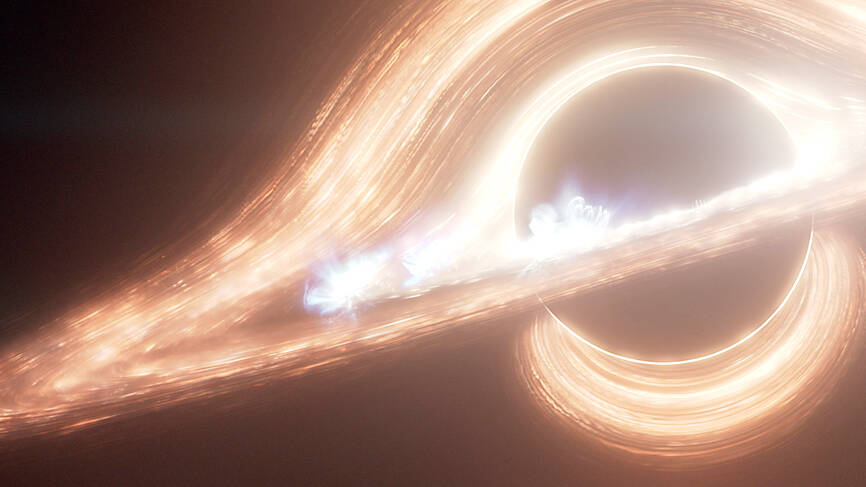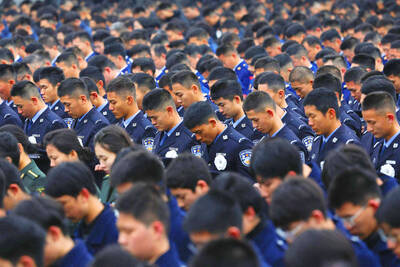Scientists have detected ripples in space-time from the violent collision of two massive black holes that spiralled into one another far beyond the distant edge of the Milky Way.
The black holes, each more than 100 times the mass of the sun, began circling each other long ago and finally slammed together to form an even more massive black hole about 10 billion light years from Earth.
The event is the most massive black hole merger ever recorded by gravitational wave detectors and has forced physicists to rethink their models of how the enormous objects form. The signal was recorded when it hit detectors on Earth sensitive enough to detect shudders in space-time thousands of times smaller than the width of a proton.

Photo: Reuters
“These are the most violent events we can observe in the universe, but when the signals reach Earth, they are the weakest phenomena we can measure,” said Mark Hannam, head of the Gravity Exploration Institute at Cardiff University. “By the time these ripples wash up on Earth they are tiny.”
Evidence for the black hole collision arrived just before 2pm UK time on Nov. 23, 2023, when two US-based detectors in Washington and Louisiana, operated by the Laser Interferometer Gravitational-wave Observatory (LIGO), twitched at the same time.
The sudden spasm in space-time caused the detectors to stretch and squeeze for 1/10th of a second, a fleeting moment that captured the so-called ringdown phase as the merged black holes formed a new one that “rang” before settling down.
Analysis of the signal revealed that the colliding black holes were 103 and 137 times the mass of the sun and spinning about 400,000 times faster than Earth, close to the theoretical limit for the objects.
“These are the highest masses of black holes we’ve confidently measured with gravitational waves,” said Hannam, a member of the LIGO scientific collaboration. “And they’re strange, because they are slap bang in the range of masses where, because of all kinds of weird things that happen, we don’t expect black holes to form.”
Most black holes form when massive stars run out of nuclear fuel and collapse at the end of their life cycle. The incredibly dense objects warp space-time so much that they create an event horizon, a boundary within which even light cannot escape.
Physicists at LIGO suspect the black holes that merged were themselves products of earlier mergers. That would explain how they came to be so massive and why they were spinning so fast, as merging black holes tend to impart spin on the object they create.
“We’ve seen hints of this before, but this is the most extreme example where that’s probably what’s happening,” Hannam said.
Scientists have detected about 300 black hole mergers from the gravitational waves they generate. Until now, the most massive merger known produced a black hole about 140 times the mass of the sun. The latest merger produced a black hole up to 265 times more massive than the sun. Details were to be presented yesterday at the GR-Amaldi meeting in Glasgow, Scotland.

PARLIAMENT CHAOS: Police forcibly removed Brazilian Deputy Glauber Braga after he called the legislation part of a ‘coup offensive’ and occupied the speaker’s chair Brazil’s lower house of Congress early yesterday approved a bill that could slash former Brazilian president Jair Bolsonaro’s prison sentence for plotting a coup, after efforts by a lawmaker to disrupt the proceedings sparked chaos in parliament. Bolsonaro has been serving a 27-year term since last month after his conviction for a scheme to stop Brazilian President Luiz Inacio Lula da Silva from taking office after the 2022 election. Lawmakers had been discussing a bill that would significantly reduce sentences for several crimes, including attempting a coup d’etat — opening up the prospect that Bolsonaro, 70, could have his sentence cut to

China yesterday held a low-key memorial ceremony for the 1937 Nanjing Massacre, with Chinese President Xi Jinping (習近平) not attending, despite a diplomatic crisis between Beijing and Tokyo over Taiwan. Beijing has raged at Tokyo since Japanese Prime Minister Sanae Takaichi last month said that a hypothetical Chinese attack on Taiwan could trigger a military response from Japan. China and Japan have long sparred over their painful history. China consistently reminds its people of the 1937 Nanjing Massacre, in which it says Japanese troops killed 300,000 people in what was then its capital. A post-World War II Allied tribunal put the death toll

A passerby could hear the cacophony from miles away in the Argentine capital, the unmistakable sound of 2,397 dogs barking — and breaking the unofficial world record for the largest-ever gathering of golden retrievers. Excitement pulsed through Bosques de Palermo, a sprawling park in Buenos Aires, as golden retriever-owners from all over Argentina transformed the park’s grassy expanse into a sea of bright yellow fur. Dog owners of all ages, their clothes covered in dog hair and stained with slobber, plopped down on picnic blankets with their beloved goldens to take in the surreal sight of so many other, exceptionally similar-looking ones.

‘UNWAVERING ALLIANCE’: The US Department of State said that China’s actions during military drills with Russia were not conducive to regional peace and stability The US on Tuesday criticized China over alleged radar deployments against Japanese military aircraft during a training exercise last week, while Tokyo and Seoul yesterday scrambled jets after Chinese and Russian military aircraft conducted joint patrols near the two countries. The incidents came after Japanese Prime Minister Sanae Takaichi triggered a dispute with Beijing last month with her remarks on how Tokyo might react to a hypothetical Chinese attack on Taiwan. “China’s actions are not conducive to regional peace and stability,” a US Department of State spokesperson said late on Tuesday, referring to the radar incident. “The US-Japan alliance is stronger and more